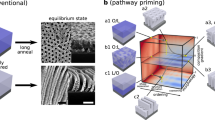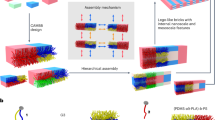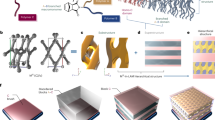Abstract
Self-assembly is emerging as an elegant, ‘bottom-up’ method for fabricating nanostructured materials1,2,3,4,5,6,7,8. This approach becomes particularly powerful when the ease and control offered by the self-assembly of organic components is combined with the electronic, magnetic or photonic properties of inorganic components2,5,9. Here we demonstrate a versatile hierarchical approach for the assembly of organic–inorganic, copolymer–metal nanostructures in which one level of self-assembly guides the next. In a first step, ultrathin diblock copolymer films form a regular scaffold of highly anisotropic, stripe-like domains10,11,12. During a second assembly step, differential wetting guides diffusing metal atoms to aggregate selectively along the scaffold, producing highly organized metal nanostructures. We find that, in contrast to the usual requirement of near-equilibrium conditions for ordering2,3,13, the metal arranged on the copolymer scaffold produces the most highly ordered configurations when the system is far from equilibrium. We delineate two distinct assembly modes of the metal component—chains of separate nanoparticles and continuous wires—each characterized by different ordering kinetics and strikingly different current–voltage characteristics. These results therefore demonstrate the possibility of guided, large-scale assembly of laterally nanostructured systems.
This is a preview of subscription content, access via your institution
Access options
Subscribe to this journal
Receive 51 print issues and online access
$199.00 per year
only $3.90 per issue
Buy this article
- Purchase on Springer Link
- Instant access to full article PDF
Prices may be subject to local taxes which are calculated during checkout




Similar content being viewed by others
References
Boal, A. K. et al. Self-assembly of nanoparticles into structured spherical and network aggregates. Nature 404, 746–748 (2000).
Black, C. T., Murray, C. B., Sandstrom, R. L. & Sun, S. Spin-dependent tunneling in self-assembled cobalt-nanocrystal superlattices. Science 290, 1131–1134 (2000).
Gau, H., Herminghaus, S., Lenz, P. & Lipowsky, R. Liquid morphologies on structured surfaces: from microchannels to microchips. Science 283, 46–49 (1999).
Higgins, A. M. & Jones, R. A.L. Anisotropic spinodal dewetting as a route to self-assembly of patterned surfaces. Nature 404, 476–478 (2000).
Thurn-Albrecht, T. et al. Ultrahigh-density nanowire arrays grown in self-assembled diblock copolymer templates. Science 290, 2126–2129 (2000).
Park, M., Harrison, C., Chaikin, P. M., Register, R. A. & Adamson, D. H. Block copolymer lithography: periodic arrays of ∼1011 holes in 1 square centimeter. Science 276, 1401–1404 (1997).
Spatz, J. P., Mössmer, S., Hartmann, C. & Möller, M. Ordered deposition of inorganic clusters from micellar block copolymer films. Langmuir 16, 407–415 (2000).
Whitesides, G. M., Mathias, J. P. & Seto, C. T. Molecular self-assembly and nanochemistry: A chemical strategy for the synthesis of nanostructures. Science 254, 1312–1319 (1991).
Sanchez, C. & Lebeau, B. Design and properties of hybrid organic-inorganic nanocomposites for photonics. Mater. Res. Soc. Bull. 26, 377–387 (2001).
Fasolka, M. J. & Mayes, A. M. Block copolymer thin films: physics and applications. Annu. Rev. Mater. Res. 31, 323–355 (2001).
Morkved, T. L. & Jaeger, H. M. Thickness-induced morphology changes in lamellar diblock copolymer ultrathin films. Europhys. Lett. 40, 643–648 (1997).
Tang, W. H. & Witten, T. A. Quenched degrees of freedom in symmetric diblock copolymer thin films. Macromolecules 31, 3130–3135 (1998).
Harrison, C. et al. Mechanisms of ordering in striped patterns. Science 290, 1558–1560 (2001).
Balazs, A. C. Interactions of nanoscopic particles with phase-separating polymeric mixtures. Curr. Opin. Colloid Interface Sci. 4, 443–448 (2000).
Morkved, T. L., Wiltzius, P., Jaeger, H. M., Grier, D. G. & Witten, T. A. Mesoscopic self-assembly of gold islands on diblock-copolymer films. Appl. Phys. Lett. 64, 422–424 (1994).
Morkved, T. L. et al. Local control of microdomain orientation in diblock copolymer thin films with electric fields. Science 273, 931–933 (1996).
Cole, D. H., Shull, K. R., Rehn, L. & Baldo, P. Metal-polymer interactions in a polymer/metal nanocomposite. Phys. Rev. Lett. 78, 5006–5009 (1997).
Lin, B. et al. X-ray studies of polymer/gold nanocomposites. J. Appl. Phys. 85, 3180–3184 (1999).
Guico, R. S., Richter, A. G., Wang, J. & Shull, K. R. X-ray standing wave measurements of gold nanoparticles in polymeric thin films. Polymeric Materials: Science & Engineering (Abst.) 85, (American Chemical Society, Washington, in the press).
Piuz, F. & Borel, J. P. Thermodynamical size effect in small particles of silver. Phys. Status Solidi A 14, 129–133 (1972).
Wu, S. Polymer Interfaces and Adhesion (Marcel Decker, New York, 1982).
Gerenser, L. J. & Goppert-Berarducci, K. E. in Metallized Plastics 3: Fundamental and Applied Aspects (ed. Mittal, K. L.) 163–178 (Plenum, New York, 1992).
Lopes, W. Non-equilibrium self-assembly of metals on diblock copolymer templates. Phys. Rev. E (submitted).
Ford, E. M. & Ahmed, H. Control of Coulomb blockade characteristics with dot size and density in planar metallic multiple tunnel junctions. Appl. Phys. Lett. 75, 421–423 (1999).
Morkved, T. L., Lopes, W. A., Hahm, J., Sibener, S. J. & Jaeger, H. M. Silicon nitride membrane substrates for the investigation of local structure in polymer thin films. Polymer 39, 3871–3875 (1998).
Cordan, A. S. et al. Temperature behavior of multiple tunnel junction devices based on disordered dot arrays. J. Appl. Phys. 87, 345–352 (2000).
Acknowledgements
We thank T. Witten, S. Coppersmith, T. Morkved, M. Möller and K. Shull for discussions, and R. Parthasarathy for help with some of the I–V measurements. This work was supported by the MRSEC programme of the NSF and by the W. M. Keck Foundation.
Author information
Authors and Affiliations
Corresponding author
Rights and permissions
About this article
Cite this article
Lopes, W., Jaeger, H. Hierarchical self-assembly of metal nanostructures on diblock copolymer scaffolds. Nature 414, 735–738 (2001). https://doi.org/10.1038/414735a
Received:
Accepted:
Issue Date:
DOI: https://doi.org/10.1038/414735a
This article is cited by
-
Self-assembled pagoda-like nanostructure-induced vertically stacked split-ring resonators for polarization-sensitive dichroic responses
Nano Convergence (2022)
-
Reversible electrical percolation in a stretchable and self-healable silver-gradient nanocomposite bilayer
Nature Communications (2022)
-
Formation Mechanism of Well-Ordered Densely Packed Nanoparticle Superlattices Deposited from Gas Phase on Template-Free Surfaces
Nanoscale Research Letters (2021)
-
Bidimensional lamellar assembly by coordination of peptidic homopolymers to platinum nanoparticles
Nature Communications (2020)
-
Ultra-dense (~20 Tdot/in2) nanoparticle array from an ordered supramolecular dendrimer containing a metal precursor
Scientific Reports (2019)
Comments
By submitting a comment you agree to abide by our Terms and Community Guidelines. If you find something abusive or that does not comply with our terms or guidelines please flag it as inappropriate.



